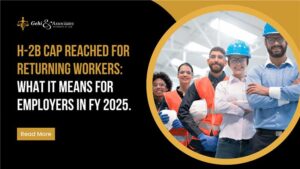Thousands of U.S. employers plan seasonal hiring around the federal H-2B visa program every year. That plan hit a hard stop when the H-2B visa cap FY 2025 was reached unexpectedly fast. The USCIS announced that on April 18, 2025, supplemental allocations of 19,000 visas for returning H-2B workers had been exhausted. These allocations were for the early second half of the fiscal year. That means countless landscaping firms, hospitality providers, seafood processors, and construction companies were left without essential personnel.
These businesses had relied on consistent labor from experienced returning workers. The impact? Immediate. Operations slowed, projects stalled, services delayed, and questions began pouring in. The government tried to accommodate needs through a temporary final rule allowing up to 64,716 additional visas. However, the reality is more sobering. Most of those were restricted to returning workers, and the system’s rigidity meant that thousands of employers still fell short.
These denials carry direct financial consequences. From raised prices to cutbacks in services, employers across the country are now recalibrating everything. At Queens Immigration Attorney, we examine employer responses and potential reforms currently making their way through legislative and policy circles.
Key Statistics:
- The filing period for this segment opened on March 20 and closed just 29 days later.
- Only employers suffering “irreparable harm” could apply for these supplemental H-2B returning worker visas.
- The 64,716 supplemental H-2B visas made available for FY 2025 included 44,716 for returning workers and 20,000 for country-specific allocations.
- The first 33,000 cap-subject H-2B visas for FY 2025 were met by September 18, 2024. That is for jobs starting before April 1, 2025.
- As of January 7, 2025, USCIS had already reached the cap for the first half of FY 2025. For the returning worker allocation of 20,716 visas.
- The regular annual H-2B cap remains fixed at 66,000 visas, divided into 33,000 per half fiscal year.
H-2B Visa Cap FY 2025 Provisions
The Department of Homeland Security and the Department of Labor authorized a one-time increase of 64,716 H-2B visas. This was done through a Temporary Final Rule in FY 2025. Of these, 44,716 visas were strictly reserved for returning workers. Those who already held H-2B status in one of the three prior fiscal years (2022, 2023, or 2024). Employers eagerly anticipated this allocation to meet immediate labor shortages across various sectors such as landscaping, hospitality, and seafood processing. However, what was meant to relieve pressure turned into a race against time.
The Allocation Slices
The 64,716 supplemental H-2B visas for FY 2025 were divided into four major allocations:
- 20,716 visas for returning workers with employment start dates on or before March 31, 2025.
- 19,000 visas for returning workers starting work between April 1 and May 14, 2025 (the early second half).
- 5,000 visas for returning workers starting from May 15 to September 30, 2025 (the late second half).
- 20,000 visas for nationals of El Salvador, Guatemala, Honduras, Haiti, Colombia, Ecuador, and Costa Rica. Not subject to the returning worker rule.
The 19,000 early second-half visas filled in less than a month. Demand overwhelmed supply, highlighting the disconnect between statutory caps and market realities. Employers had to act fast. This wasn’t just a matter of submitting paperwork. Timing, accuracy, and eligibility all had to align.
Final Receipt Dates That Shut the Door
The deadline for submitting petitions for the 19,000 early second-half returning worker visas passed on April 18, 2025. Petitions received after that date were automatically rejected, no matter how complete or compelling.
This proved catastrophic for employers who underestimated processing times, misunderstood filing windows, or failed to coordinate with legal counsel. An experienced immigration attorney helps check compliance with eligibility rules. They complete the required attestation and prepare the documentation needed to prove irreparable harm.
Who Qualified Under the Returning Worker Rule?
To qualify for the returning worker visas, employees must have held H-2B status in FY 2022, 2023, or 2024. Employers needed to affirm this status for each worker and document it in their filing. Further, employers had to complete and submit the new Form ETA 9142-B-CAA-9, which replaced outdated versions from prior years.
This form required petitioners to attest, under penalty of perjury, that the workers they sought were returning H-2B beneficiaries. And that their business would suffer irreparable harm without them. DHS emphasized that outdated versions of this form would lead to automatic rejections. Many employers made this mistake, unknowingly disqualifying their petitions.
Petitioning Errors That Led to Rejections
Petitions failed for several recurring reasons under the constraints of the H-2B visa cap FY 2025. All preventable with proper guidance:
- Employers checked multiple allocation boxes instead of one, violating eligibility protocols.
- Petitioners submitted expired forms or used outdated versions of the attestation.
- Employment start dates did not match those listed in the certified Temporary Labor Certification (TLC).
- Petitions were mailed to the wrong service center location.
Irreparable Harm Standard: Easy to Claim, Hard to Prove
Employers were required to prove they would suffer “irreparable harm” if they could not employ the H-2B returning workers. This wasn’t a casual claim. It had to be affirmed legally via Form ETA 9142-B-CAA-9 and backed by specific evidence retained for 3 years.
To meet this standard, employers had to prepare a written statement detailing the financial or operational damage that would occur. For example:
- Loss of seasonal contracts
- Inability to fulfill existing service agreements
- Delayed opening of hospitality facilities
- Substantial revenue reductions tied to worker unavailability
Failure to prepare this documentation or submit it in time led to petition denial and possible audit. Especially under the heightened scrutiny triggered by the H-2B visa cap FY 2025. DHS and DOL have stated that many post-adjudication audits are planned to enforce integrity.
Not sure which U.S. work visa fits your goals? Explore your options here.
Sectors Facing the Steepest Operational Cost Increases Due to the H-2B visa Cap FY 2025
For many employers, the consequences of the H-2B visa cap FY 2025 go far beyond unfilled roles. These employers depend on seasonal foreign labor. They are now grappling with rising operational costs, service cutbacks, and significant financial restructuring. The denial of returning workers, experienced laborers familiar with industry cycles, has left many sectors facing steep productivity losses. But this isn’t about staffing inconvenience; it’s about measurable, budget-breaking impacts on profit and loss statements.
Landscaping and Hospitality
The landscaping and hospitality industries are among the most heavily dependent on H-2B workers. They were the first to feel the pain. These sectors rely on peak-season surges in labor that domestic markets can’t always meet. Many of these businesses were left without their expected workforce.
In Queens and similar urban markets, hospitality businesses report adjusting guest services. With reducing room availability or offering fewer amenities during high-demand weeks. Landscaping firms have been forced to reduce their crews, extend project timelines, or pay overtime to smaller staff. Especially those with municipal or commercial contracts.
Seafood and Manufacturing
Denied returning worker visas also hit seafood processing and light manufacturing hard. These industries require consistent, trained hands to meet strict production schedules. Without their seasonal H-2B workforce, processors in affected states have slowed operations. With the H-2B visa cap FY 2025 limits abruptly reached, seafood and manufacturing companies scrambled to renegotiate contracts. While absorbing penalties for missed deliveries.
Economic Pass-Through
What happens when business costs increase, and labor disappears? Consumers pay the price. In regions like New York and Florida, businesses without returning H-2B workers have passed those costs to the customer. Hospitality providers now charge resort fees to offset service shortages. Landscaping companies bill more for emergency services and seasonal clean-ups. Even food producers are quietly raising menu prices to deal with shipping and prep labor losses.
How Are Employers Re-Engineering Recruitment Pipelines Post H-2B visa cap FY 2025?
With the H-2B visa cap FY 2025 reached for returning workers, many employers are shifting from reliance to reinvention. Rather than waiting for congressional reform or DHS flexibility, businesses are changing their recruitment strategies. Visa scarcity and operational necessity shape these adjustments as proactive survival strategies.
Automation and AI in Hospitality
In response to returning worker denials, hospitality employers are turning to technology. Hotels and restaurants have started implementing automation to bridge service gaps. This includes self-check-in kiosks, touchless payment systems, and robotic kitchen assistants to maintain workflow.
The loss of experienced H-2B workers forced many businesses to fast-track automation investments. These tools prevent cancellations, maintain customer service standards, and preserve brand reputation. This shift may mark a permanent change in how labor is balanced across service roles.
Offshore Subcontracting
Denied visa petitions have accelerated offshore subcontracting in the construction and design sectors. Many companies turned to overseas firms for prefabrication and architectural drafting. This strategy allows U.S.-based employers to reduce on-site labor needs while maintaining delivery timelines.
Leveraging Non-Visa Labor Pools
Some employers are filling the gap by tapping underutilized local labor pools. These include retirees seeking part-time work, formerly incarcerated individuals re-entering the workforce, and student populations available for seasonal jobs.
To attract these groups, businesses are offering flexible shifts, training incentives, and in some cases, tax credits. However, these workers often require greater onboarding and oversight, making legal compliance a concern. A Queens immigration attorney can assist with proper onboarding and compliance for alternative domestic labor.
FAQs
What is the H-2B quota for 2025? The statutory cap is 66,000. DHS added 64,716 more for FY 2025 under temporary authority. These additional visas were divided into specific allocations for returning workers and nationals of designated countries.
What are the changes in citizenship 2025? No structural changes. However, final rules about modernization and portability went into effect on January 17, 2025. These rules aim to streamline naturalization applications and improve employment-based immigration efficiency.
Can I extend my H-2B visa after 3 years? No. After 3 years, H-2B workers must leave the U.S. for at least 3 months before reapplying. This mandatory break prevents long-term stays under a temporary visa category.
What is the 5-month rule for an F1 visa? F1 students cannot be outside the U.S. for more than 5 months without affecting their status. Exceeding this limit without proper authorization results in the termination of student status and SEVIS record.
Do H-2B visa workers pay taxes? Yes. They pay federal income taxes and may be subject to Social Security and Medicare, depending on exemptions. Employers must withhold taxes appropriately, and workers may be eligible for refunds depending on tax treaties.
What is the 7-year rule for immigrants? This generally refers to cancellation of removal eligibility, not applicable to H-2B workers. To qualify, individuals must show continuous U.S. presence for 7 years and meet specific hardship criteria.
Protect Your Workforce with Queens Immigration Attorney
The early closure of the H-2B visa cap FY 2025 was a move that affected thousands of employers. Returning H-2B workers supplements U.S. workers when no qualified or willing domestic labor exists. They are vetted, experienced, and seasonally indispensable. When their visas are denied, operations halt, revenues drop, and communities like Queens feel the fallout.
At Queens immigration attorney, we help position your petition for success. By anticipating regulatory shifts and preparing you to fight for cap-exempt or late-season relief. Begin today by scheduling a free consultation!





